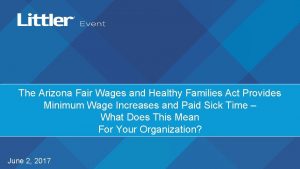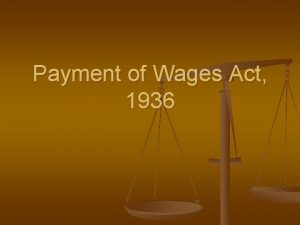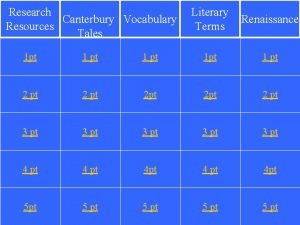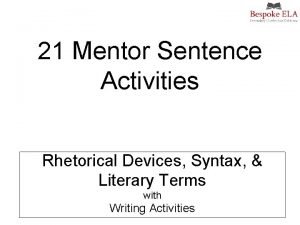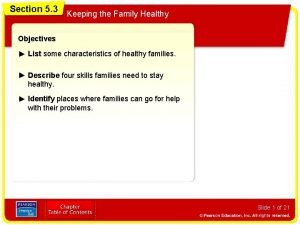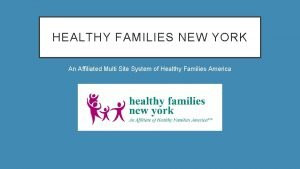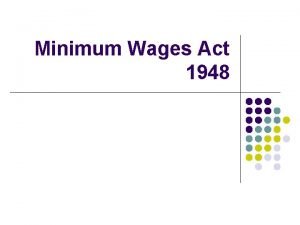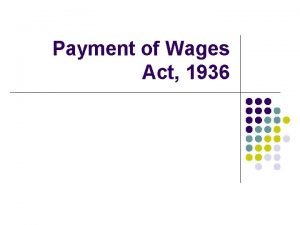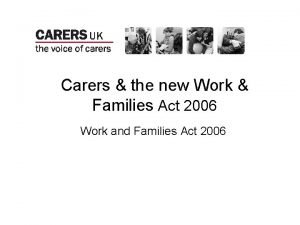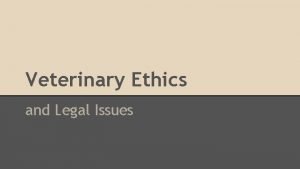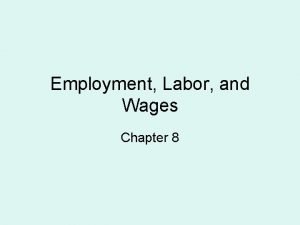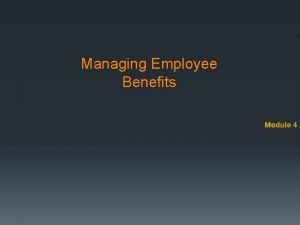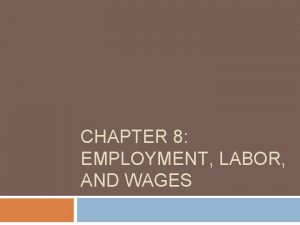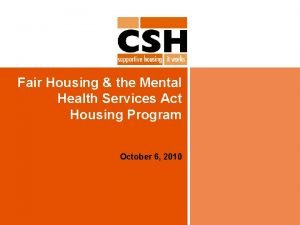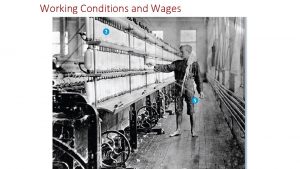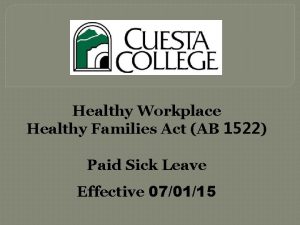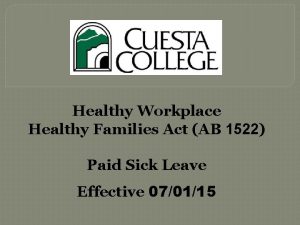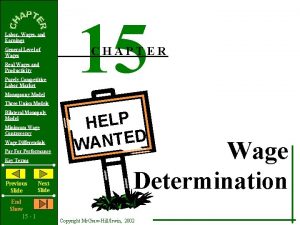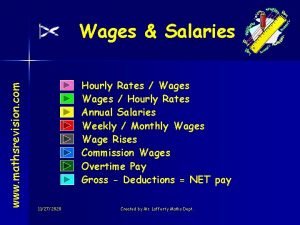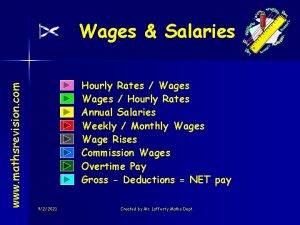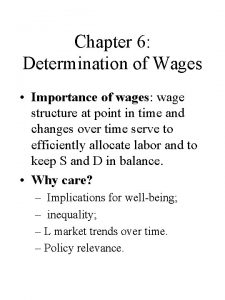The Arizona Fair Wages and Healthy Families Act































- Slides: 31

The Arizona Fair Wages and Healthy Families Act Provides Minimum Wage Increases and Paid Sick Time – What Does This Mean For Your Organization? June 2, 2017

Presented By Melissa Shingles Attorney Littler Mendelson, P. C. Phoenix MShingles@littler. com 602. 474. 3610 Sarah Watt Attorney Littler Mendelson, P. C. Phoenix SWatt@littler. com 602. 474. 3641

About Littler • • • Littler is the largest global employment and labor law practice, with more than 1, 200 attorneys in over 75 offices worldwide. Littler represents management in all aspects of employment and labor law and serves as a single-source solution provider to the global employer community. Consistently recognized in the industry as a leading and innovative law practice, Littler has been litigating, mediating and negotiating some of the most influential employment law cases and labor contracts on record for over 75 years. Littler Global is the collective trade name for an international legal practice, the practicing entities of which are separate and distinct professional firms. For more information visit littler. com. © Littler Presentation | 2017 Proprietary and Confidential

Agenda • • Nation-Wide Context PST Rules and Basics Overview of Hidden Surprises of the Act Implementation Considerations – New v. Existing Banks – “PTO” vs. Separate Sick and Vacation Banks © Littler Presentation | 2017 Proprietary and Confidential

Overview of AZ Prop 206 (Or the new A. R. S. § § 23 -363 & 23 -364) • Enacted on November 8, 2016 • Also known as the Fair Wages and Healthy Families Act (“FWHFA”) • Amends the Arizona Minimum Wage Act (“AMWA”) to provide for incremental increases to the minimum wage for Arizona workers beginning on January 1, 2017 with an increase to $10. 00/hour • Requires that, beginning July 1, 2017, all Arizona workers shall accrue, and have the legal right to use, a minimum amount of “Paid Sick Time” benefits each year © Littler Presentation | 2017 Proprietary and Confidential

Key Provisions of the Act

Minimum Wage Effective Date January 1, 2017 January 1, 2018 January 1, 2019 Minimum Wage $10. 00 per hour $10. 50 per hour $11. 00 per hour January 1, 2020 January 1, 2021+ $12. 00 per hour $9. 00 per hour plus tips Annual cost of living adjustments © Littler Presentation | 2017 Proprietary and Confidential Minimum Wage – Tipped $7. 00 per hour plus tips $7. 50 per hour plus tips $8. 00 per hour plus tips

PST Accrual and Use • PST accrues at a rate of no less than one hour for every 30 hours actually worked – For FLSA “exempt” EEs’ accrual, the statute assumes the EE works 40 hours per week – If an exempt employee’s normal workweek is less than 40 hours, his or her PST accrues based on the actual number of hours worked in that normal workweek • Accrual and Use Caps – For employers with ≥ 15 employees, maximum accrual and use of 40 hours of PST per year, unless a higher limit selected by employer – For employers with <15 employees, maximum accrual and use of 24 hours of PST per year, unless a higher limit selected by employer © Littler Presentation | 2017 Proprietary and Confidential

Determining Employee Count • Number of EEs on the payroll in any state for some portion of a day for twenty (20) calendar weeks in the current or preceding year • Weeks do not have to be consecutive, any 20 weeks in the current or preceding year with ≥ 15 employees on the payroll will count • All full time, part time, and temporary employees anywhere are counted • Only Arizona employees are entitled to PST © Littler Presentation | 2017 Proprietary and Confidential

Paid Sick Time Use • General Rule of Thumb: An employee may use earned PST as it is accrued, subject to applicable use caps. – In the smaller of either hourly increments or “the smallest increment that the employer’s payroll system uses to account for absences or use of other time. ” • Typical PST increment is hourly – While all EEs must begin to accrue PST under the Act on July 1, 2017 or their date of hire, whichever is later, an employer may require that EEs hired after July 1, 2017 wait 90 days from their DOH before they can use accrued PST. © Littler Presentation | 2017 Proprietary and Confidential

“Family Member” means…. • Much broader definition than under the FMLA: − a spouse or legally registered domestic partner, − a grandparent (or person who stood in loco parentis of an employee or his or her spouse or domestic partner) − grandchild, − sibling, − A biological child, adopted child, foster child, stepchild, of the employee or the employee’s spouse or domestic partner, regardless of age, − a child to whom the employee or employee’s spouse or domestic partner stands or stood in loco parentis, regardless of age, − and any other individual related by blood or affinity whose close relationship is the equivalent of a family relationship. © Littler Presentation | 2017 Proprietary and Confidential

Can Be Used Upon Request For: • An employee’s own mental or physical illness, injury or health condition, or the employee’s need to seek medical diagnosis, treatment, or preventative care; • A family member’s mental or physical illness, injury or health condition, or the family member’s need to seek medical diagnosis, treatment, or preventative care; • Closure of the employee’s workplace due to a public health emergency, or an employee’s need to care for a child whose school or place of care has been closed due to a public health emergency; • When an employee or employee’s family member’s “presence in the community may jeopardize the health of others” due to exposure or suspected exposure to a communicable disease; and • Absences due to domestic violence (such as counseling or court matters), sexual violence, abuse, or stalking of an employee or employee’s family member, as these terms are defined in the statute, if the leave is to address the psychological, physical, or legal effects on the employee or the employee’s family member. © Littler Presentation | 2017 Proprietary and Confidential

Carryover Rule and Borrowing • PST Carryover – An employee must be permitted to carry over unused, accrued PST to the “following year” • It is unclear whether carryover must be indefinite, i. e. an employee can carry over multiple years of accrued, unused PST for several years, thereby accumulating a bank in excess of 40, 80, or 120 hours… • Forthcoming regulations may address this or impose a “carryover cap” – However, hours carried over cannot be used in excess of the annual use cap (24 or 40 hours) • PST Borrowing – An employer may permit an EE to borrow from subsequent year if it chooses – Be careful: there is no provision in the statute speaking to an employer’s ability to recover borrowed PST if the employee in question separates from employment before he or she actually accrues the borrowed PST – At a minimum, ensure you are complying with A. R. S. § 23 -352 (requiring prior written authorization or a genuine dispute as to any recoupment amount) if you decide to recoup such borrowed PST from employees’ wages – In the absence of legislative guidance on this issue, recoupment is not without risk © Littler Presentation | 2017 Proprietary and Confidential

Requesting and Verifying PST Use • Requesting Time: – Request for PST “may be made orally, in writing, by electronic means or by any other means acceptable to the employer” – If possible, a leave request must include the expected duration of the leave – If leave is foreseeable, EEs must make a “good faith effort” to give an employer advance notice and schedule their absences in a way that lessens the impact on the employers’ business (much like FMLA leave) – For unforeseeable leave, employers may require that EEs give prior notice of the leave if the notice requirements are clearly set forth in writing and that written description is disseminated to the EE (but don’t be too strict!) • Verifying The Reason for PST Use – Employer may request “reasonable documentation” of the purpose of PST leave only where 3 or more consecutive days off are requested – Take Note: No doctor’s note may be requested for single-day absences! © Littler Presentation | 2017 Proprietary and Confidential

End-Of-Year Payout Option • An employer may exercise the option to pay out unused, accrued PST to EEs at the end of the year (as opposed to carryover), BUT: • The EE must then be given a “full” bank of accrued hours available for the employee’s immediate use at the beginning of the next year • As unused, accrued PST that is carried over is subject to annual use caps, and unused accrued PST need not be paid out upon termination, there is little incentive for employers to exercise this payout option in light of the “payout penalty” above © Littler Presentation | 2017 Proprietary and Confidential

Notice and Posting Requirements • • • Pay Statements (or in a notice provided with employee paychecks) must include – The amount of the employee’s accrued PST – The amount of PST used by the employee to date that year – The amount of pay an employee has received as earned PST Written/Posted Notice must include – Employer’s business name, address, and telephone number – Employees’ entitlement to earn PST and the rate at which employees will accrue PST; – The terms of use of PST as provided by the Act; – That retaliation against employees requesting or using PST is prohibited; – Details of the employees’ right to file a complaint if PST use is unlawfully denied or retaliated against; and – The contact information for the Commission where questions about rights and responsibilities under the Act can be answered. Written notices must be distributed on the effective date or given at time of hire, if later Posting must be made and notice must be given in English, Spanish, and “any language that is deemed appropriate by the commission. ” Sample notices in each language provided by the Arizona Industrial Commission © Littler Presentation | 2017 Proprietary and Confidential

Sample Notices • Arizona Paid Sick Time Poster 2017 (English) • Published by Arizona Industrial Commission • Contact us! © Littler Presentation | 2017 Proprietary and Confidential

Anti-Discrimination • The FWHFA prohibits discrimination and retaliation for requesting or using PST, or any other exercise of rights provided by the Act. • As with the FMLA, any PST day counts as a protected absence and cannot be used or counted toward any disciplinary or other adverse action – No more “no fault” attendance policies! • Presumption that any adverse employment action taken within 90 days of an EE’s exercise of PST rights is retaliatory, unless there is “clear and convincing” evidence otherwise – Document, document! © Littler Presentation | 2017 Proprietary and Confidential

Misc. • Reinstatement Upon Rehire. If an employer rehires a separated employee within nine (9) months, all PST that the employee had accrued at the time of his or her separation must be reinstated. • Confidentiality. An employer must treat any health or other verification information it obtains from an employee as confidential and “may only disclose it to the affected employee or with the affected employee’s permission. ” – Law offers no guidance as to an employer’s obligation to release this information if requested by subpoena or other court order, or if requested in a government investigation. We are hopeful that this issue will be addressed with forthcoming regulations. • Recordkeeping Requirements. The Act requires employers to add to their existing Arizona Minimum Wage Act recordkeeping obligations details of an employee’s PST use and accrual for four years. There is a rebuttable presumption that an employer who fails to maintain such records did not pay statutorily earned PST. © Littler Presentation | 2017 Proprietary and Confidential

Misc. Continued… • Collective Bargaining Agreements (“CBAs”). – If employees are covered by a CBA that is in effect as of the July 1, 2017 (the Act’s effective date), the Act will not apply to those CBA-covered employees until the CBA’s “stated expiration date. ” – CBAs entered into after July 1, 2017, may contain a waiver of employees’ PST entitlements under the Act if the waiver is “express” and “clear and unambiguous. ” • Waiver by Other Employment Contract. No other verbal or written agreement or employment contract may waive any rights under the Act. © Littler Presentation | 2017 Proprietary and Confidential

More Than Meets The Eye: Prop 206’s Hidden Surprises

Lurking Beneath The Surface: What you may not realize yet about Prop 206 • Under the new law, any PST day counts as a protected absence and cannot be used or counted toward disciplinary action (similar to ADA/FMLA) – The Act is a death knell for “No Fault” attendance policies in AZ • The Act carries a presumption of retaliation for any adverse employment action taken within 90 days of an EE’s exercise of PST, unless the employer has “clear and convincing” evidence otherwise • An employer can request “reasonable documentation” for use of PST only where an EE seeks to use three or more consecutive work days of PST • PST can be concurrent with FMLA, but AZ law is generally broader • PST can be taken intermittently throughout the day in one hour increments • EE may not be required to find coverage or a replacement worker for his or her use of PST © Littler Presentation | 2017 Proprietary and Confidential

Other Noteworthy Nuances… • Confusing Payout “Penalty”- If an employer elects to annually pay out unused PST, it must then provide the EE with a full bank of PST hours that will be immediately available for use • Even if an employer’s existing PTO policy is minimally compliant with the statute, there are compelling reasons to consider implementing new, separate, “Sick Time” and “Vacation Time” banks, to be discussed later… © Littler Presentation | 2017 Proprietary and Confidential

Implementation Issues Existing Leave Banks v. New Sick Time Bank © Littler Presentation | 2017 Proprietary and Confidential

What Do I Do With Existing Sick Time or PTO Leave Banks on July 1, 2017? • Proceed with caution! • The statute is silent on whether an employee’s already-accrued PST as of July 1, 2017 may be counted toward his or her statutory cap of 40 (or 24, depending on the size of the employer) hours per year for 2017 • Given the Act’s purpose and the fact that employers with existing compliant practices are not required to “offer additional benefits, ” it may be that such time could be counted toward the cap • At a minimum, employees should be permitted to retain any accrued time in their banks as of July 1, 2017, as these banks may be considered “wages” • Consider the use of a “legacy bank” • Regulations may address this issue… © Littler Presentation | 2017 Proprietary and Confidential

Retention of Existing Leave Banks Pros – If prior benefit can be reworked in minor ways to comply with applicable law, can result in no cost increase (same cost) – Culturally, may be easier to implement operational or process changes because people already know/expect to use benefit offered – Avoids common issue with implementing new PST bank: in order to remain cost neutral, is likely to be perceived as “taking away” existing days Cons – Existing banks often do not meet rate of accrual requirements – Existing banks may not cover all employees – Existing banks may far exceed the amount of paid sick time that is required under the statute, and efforts to limit existing banks face potential legality issues and implementation issues (such as ability to accurately track and report) © Littler Presentation | 2017 Proprietary and Confidential

Implementation Issues PTO v. Sick / Vacation © Littler Presentation | 2017 Proprietary and Confidential

“Combined” PTO Bank General Considerations – Low concerns re employee abuse – Low concerns re cost of sick leave (in wages and business disruption) – More likely to work with an exempt population – Carry-over provision must be applicable to all time Pros – Administrative Ease – Avoid employee discontent that may occur during a transition from PTO to separate sick and vacation banks Cons – The restrictive rules tying employers’ hands in curbing leave abuse will apply to more absences – The accrual rates and tracking must comply with the PST law for more absences – It expands the number of employees who will take PTO if many currently do not receive PTO © Littler Presentation | 2017 Proprietary and Confidential

Separate Sick / Vacation Banks General Considerations – Mid to high concerns re employee abuse – Mid to high concerns re cost of sick leave in wages and business disruption – May be preferable with substantial employee population who received PTO/Vacation previously Pros – Limit risk of making all paid time off “regulated” under paid sick leave laws – More conservative approach in terms of carry-over – Limit disruption of sick leave program (i. e. , limit ability to take job-protected leave with little or no notice) – Limit opportunity for attendance abuse by limiting amount of paid time off that may be used for vacation/personal days Cons – May require a culture shift for employees accustomed to PTO – May encourage use of more time off to preserve vacation days – Limits employee flexibility in taking short-notice leaves © Littler Presentation | 2017 Proprietary and Confidential


Thank You! This information provided by Littler is not a substitute for experienced legal counsel and does not provide legal advice or attempt to address the numerous factual issues that inevitably arise in any employment-related dispute. Although this information attempts to cover some major recent developments, it is not all-inclusive, and the current status of any decision or principle of law should be verified by counsel.
 Arizona fair wages and healthy families act
Arizona fair wages and healthy families act Little families
Little families Payment of wages act, 1936 objectives and scope
Payment of wages act, 1936 objectives and scope Foul is fair and fair is foul literary device
Foul is fair and fair is foul literary device Oxymoron in macbeth
Oxymoron in macbeth Foul is fair and fair is foul
Foul is fair and fair is foul Fair is foul and foul is fair literary device
Fair is foul and foul is fair literary device Significa fair play
Significa fair play Examples of fair is foul and foul is fair in macbeth
Examples of fair is foul and foul is fair in macbeth Lesson 3: keeping the family healthy
Lesson 3: keeping the family healthy Dc healthy families
Dc healthy families Healthy families new york
Healthy families new york The minimum wage act 1948
The minimum wage act 1948 The minimum wage act 1948
The minimum wage act 1948 Payment of wages act 1936 applicability
Payment of wages act 1936 applicability What is labour law in india
What is labour law in india 14 line sonnets
14 line sonnets Healthy food healthy mind journal
Healthy food healthy mind journal Healthy soil healthy life poster ideas
Healthy soil healthy life poster ideas Healthy forests healthy communities poster ideas
Healthy forests healthy communities poster ideas Healthy nurse healthy nation
Healthy nurse healthy nation Work and families act 2006
Work and families act 2006 Arizona veterinary practice act
Arizona veterinary practice act Act 1 act 2 act 3
Act 1 act 2 act 3 Rowan plan
Rowan plan Chapter 9 section 1 labor market trends
Chapter 9 section 1 labor market trends Chapter 8 employment labor and wages
Chapter 8 employment labor and wages Chapter 9 section 2 labor and wages worksheet answers
Chapter 9 section 2 labor and wages worksheet answers Guided reading activity 8-3 labor and wages answers
Guided reading activity 8-3 labor and wages answers Workers wages and benefits module
Workers wages and benefits module Chapter 8 employment labor and wages
Chapter 8 employment labor and wages Fair housing act mental illness
Fair housing act mental illness
